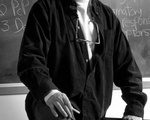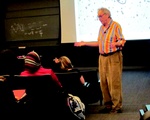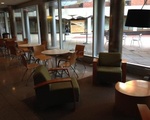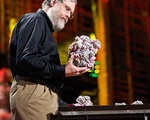Sciences Division
After 40 Years, One Last Hurrah
When Joseph D. Brain delivered the first lecture of his new physiology course “The Human Organism” in 1971, scientists had not yet eradicated smallpox, profiled DNA, or discovered HIV.
Research Conversations
Professors and students gathered together to discuss research in the humanities, social sciences, hard sciences, and quantitative studies at the second annual National Collegiate Research Conference.
Research Conference Stresses Diversity
Speaking at the second annual National Collegiate Research Conference, MIT physics professor Walter H. G. Lewin kicked off the three-day symposium with a bang—the big bang.
Defending Radicals, Integrating Radcliffe
Every week, The Crimson publishes a selection of articles that were printed in our pages in years past.
Diderot and Dissections: The World of the Non-Science Pre-Med
The challenge of filling pre-med requirements while concentrating in a non-science field has spread some students across multiple disciplines.
Hidden Study Spaces, Just in Time for Midterms!
With midterm season underway and constant reminders of imminent finals, stumbling across an empty reading room is often a welcome discovery.
Faculty Report Announces Contraction
The total number of ladder faculty in the Faculty of Arts and Sciences dropped from 722 to 712 between 2011 and 2012, a 1.4 percent contraction in the size of the faculty, according to the 2012 FAS Annual Report released last Thursday.
George Church Visits Colbert
On Thursday, Harvard Medical School Professor of Genetics George M. Church appeared on "The Colbert Report" with 20 million copies of his new book, co-authored with Ed Regis, in his front jacket pocket (don't worry, it's a DNA trick!). The book is called "Regenesis: How Synthetic Biology Will Reinvent Nature and Ourselves," and according to Colbert, it may contain information that "will eventually destroy all of mankind." In reality, the book is actually about the many possibilities presented by synthetic biology, one of which is digital information storage in DNA.
Jones Tackles Medical Ethics and History
Professor David S. Jones ’97 is the A. Bernard Ackerman Professor of the Culture of Medicine and this year he is teaching a new, wildly popular class entitled Ethical Reasoning 33: “Medical Ethics and History.” In his most recent article in the New England Journal of Medicine, he explores the evolution of therapeutics from the days of blood-letting to what we see today.
Sheila Jasanoff
William Clark, Rebecca Henderson, John Spengler, Bill McKibben, Frances Beinecke, Andrew Revkin, Sheila Jasanoff, and James McCarthy field questions at the Science & Advocacy discussion.
CS 50 Office Hours To Move To Annenberg
Starting this semester, Computer Science 50: “Introduction to Computer Science I” office hours will be held in Annenberg to facilitate interaction between students and the course staff.
A Harvard Reunion for Civil War Vets
Every week, The Crimson publishes a selection of articles that were printed in our pages in years past. June 18, 1914: Class of 1864 Holds Reunion The 50th anniversary of their graduation has brought back to the reunion in Phillips Brooks House today nearly all of the 36 living members of the Class of 1864. There were 99 men in '64 who completed their four years and 44 who were associated with the class for a part of that time. The large number of men who did not graduate is accounted for by the fact that many of them went to war. Forty-one members of the class, either graduate or associate, took part in the Rebellion—35 in the Union Army and six in the Confederate Army. Of the 99 graduates, almost every one took a further degree than the A.B., and more than a third studied medicine or law.












